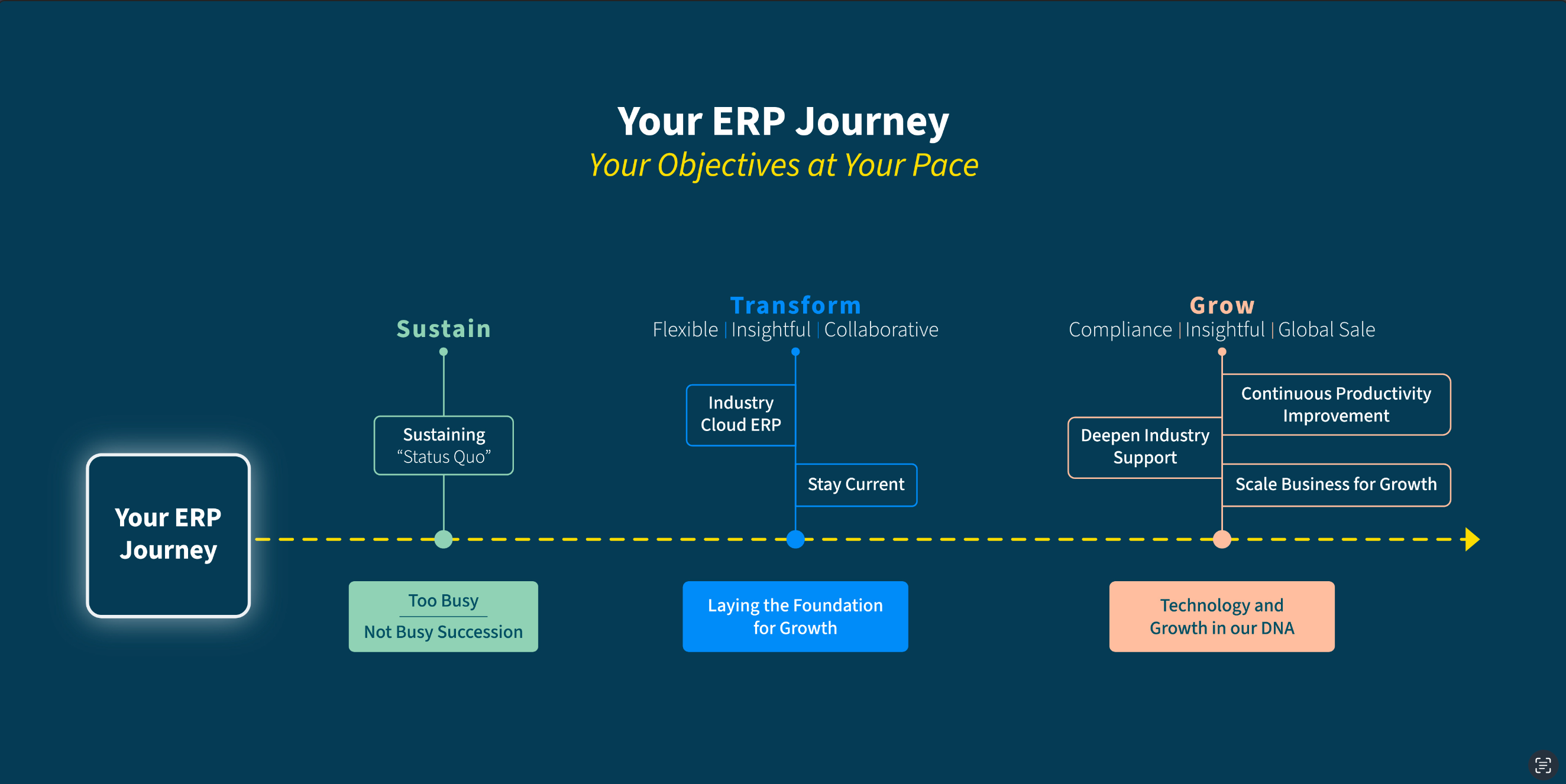Delivering on business performance goals isn’t easy. To optimise your success, you need technology solutions that can easily pivot to meet your needs while controlling key processes—all without added complexity or cost. The right solutions can scale to accommodate your growth today and into the future, without disruption. Careful management of the ERP lifecycle is a vital initiative for all businesses seeking to meet strategic business goals.
If you feel like you’ve fallen behind in this area, you’re not alone. Gartner® Research reports that "According to our surveys, nearly 69% of ERP decision-makers agreed that their current ERP strategies were not strongly aligned to their organisations’ business strategies.*" Aligning business strategies to the use of ERP can reduce risk and promote greater business continuity, transform your workforce to deliver a competitive advantage, and provide the scalability you need to help ensure growth.
The Downside of Sustaining ERP–The Old Shoe Theory
We get it. Your current ERP feels like an old shoe. It’s comfortable. Sustaining ERP systems only to maintain the status quo may “keep the lights on,” but ultimately offers limited value for changing business objectives. Businesses with “stale” ERP solutions often have succumbed to other priorities, not realising that their business is suddenly two, three, or more years behind. They suddenly become aware that they are now lagging in updates and stuck with a limited roadmap that merely fixes bugs to keep things minimally compliant.
If this is you, merely coasting along with what’s comfortable won’t help you improve business performance or get the edge in competitive markets. More important, it puts your business at risk of falling behind, or worse; you could face disruption from cybersecurity issues or system failure. Building the importance of staying current into the fiber of your company culture—whether through consistent upgrade programs or by moving to the cloud—protects the ongoing success of your business.
“With Epicor Cloud Enterprise Services for Kinetic, we’re looking out the windshield, not in the rearview mirror." Josh Owings, Director of Enterprise Applications │ JR Automation
A Strong Foundation for Workforce Performance and Growth
Transformation lays the foundation for growth with new levels of flexibility, business insights, and collaborative experiences for your employees. Modernising your foundational ERP delivers a toolset to your workforce that promotes independence and self-service: you’ll benefit from greater access to business data for faster decision-making, easy-to-use tools for configuration and automation of key business processes, and a culture of innovation through digital collaboration. Optimising your workforce performance with current ERP is investing in your future—with a solid foundation in place, you’re ready to move to the next stage of ERP for growth.
"Epicor Kinetic is the foundation of our business. It gives us the synergies and visibility that we were lacking before. Now we have a single, consolidated financial point of view, in terms of what we are ordering and purchasing, as well as inventory control, production, and shipping." Steve Savary, Vice President of IT │ A.Y. McDonald
Technology and Growth—Your Objectives, Your Pace
As your business enters this stage, you have technology and growth as part of your enterprise DNA. Now you’re ready to accomplish business objectives through deepened industry support, global capabilities, and compliance standards that align with industry requirements. You’re looking to scale the business through acquisitions, organic growth, or perhaps by placing business units closer to your customers through regional or global expansion. And finally, you’re seeking to be more productive with modular ERP projects in a phased approach, at a pace that works for you.
This could mean extending your reach with eCommerce or optimising your transport operations through integrated shipping solutions. Supplier portals that can deliver greater oversight across your supply chain while digitising your operations can empower you to remove those file cabinets once and for all. Your strategic objectives for ERP should align with your goals, at your pace—streamlining daily operations and helping deliver lasting results.
“Epicor works on a building block approach that gives us the choice to easily add or enable modules as and when required.” Mario Foster, Group CIO │ Al Naboodah Enterprises
Beginning Your Digital Transformation
First things first: assemble your team members. These should be the leaders who depend on ERP and understand the impact it can bring to your business. Include a few change agents in the group—those who understand the impact of technology and can help sell change within your organisation. Next, model your business processes to determine where you can derive the most value from transforming your current ERP solution. If you’re not sure where to start, consider engaging a third party to help facilitate this process; there are many organisations that focus on helping businesses take this step. When you’re ready to choose an ERP system, these six criteria can help you reduce your risk and find the solution that meets your unique needs:
- Confidence in the company. Selecting a vendor to partner with is very important, as most businesses only change ERP vendors every 10 years.
- Compatibility with the product. Considerations around solution fit include the size of business the vendor targets (are they focused on small or mid-size businesses?) and process alignment (what specialty industries do they focus on, and are these applicable to your daily processes?). When checking references, it’s helpful to choose companies with similar business structures and goals.
- Evolution of the technology. Vendors without a cloud offering should be avoided as they aren’t moving forward. Today’s modern ERP provides a flexible architecture that supports no-low-code configurations, automation toolsets, self-service analytics, and integration/interoperability to extend when and where you need to. It’s also critical to look for a strong roadmap.
- Support for the implementation. What resources are available, and at what cost, to help you implement the solution? Are partners available to oversee the process? If yes, do they have experience with your type of business? How much customisation or configuration is needed for implementation, and how does that affect the timeframe?
- Help after the go-live. What resources are there once your solution is up and running? Where does this support come from, and when is it available? What about self-service options? Are there any user groups or forums you can participate in?
- Total cost of ownership. Considerations here include future scaling of the solution as well as cost savings from outsourcing IT functions through migration to the cloud.
Whether your next stage is transformation or growth, Epicor is ready to be your trusted partner. We have helped over 21,000 businesses worldwide with cloud ERP solutions designed to reduce risk, increase business continuity, and transform their workforce to drive a competitive advantage. Learn more about how Epicor can help provide the scalability you need to thrive and grow.
*Gartner, The Best Strategies Run on Strong Value Stories, 13 January 2023, Dixie John, Tim Faith. GARTNER is a registered trademark and service mark of Gartner, Inc. and/or its affiliates in the U.S. and internationally and is used herein with permission. All rights reserved.









